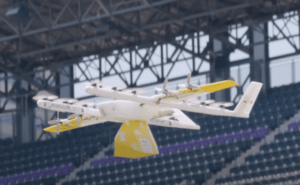
Continue reading below, or listen:
by DRONELIFE Staff Writer Ian M. Crosby
Earlier this month, Google’s Wing held a demonstration delivery at Colorado’s Coors Field, where it delivered beer and peanuts to the field. Though not held on a game day, over 1,000 people were present in the stands to celebrate the kickoff party for AUVSI’s annual autonomous systems conference.
Coors Field was selected for the demonstration due to its challenging environment. Located in Denver, Colorado, one of the country’s fastest growing cities, the stadium is filled with obstacles for delivery such as stadium seating and jumbotrons. At 5,200 feet, Coors Field sits a “mile high” in North America’s second tallest city.
As the company prepares a major expansion of its drone delivery service with the Wing Delivery Network operating model announced earlier in the year, Wing set out to demonstrate the technology’s ability to deliver nearly anywhere. The company is focused on replacing existing methods of ground-based delivery to more efficiently transport small packages across large areas.
Wing has seen major success within the increasingly dense environments in which it has operated, ranging from rural farms and lightly populated suburbs to more dense suburbs and even large metropolitan areas such as Brisbane, Australia, Helsinki, Finland, and Texas’s Dallas Fort Worth metro area. On some days, the company delivered nearly 1,000 packages a day in Brisbane, averaging at around one delivery every 25 seconds.
Wing also published significant environmental statistics about their drone delivery program:
Wing’s delivery drones are about 10x as efficient as some of the most efficient electric vehicles on the road today, and more than 50x more efficient than an average gasoline-powered vehicle.
Our drones are so efficient that when a customer orders a box of pasta from Wing, they typically use more energy boiling the water than we used delivering the package several miles to their home.
With the equivalent amount of energy a Wing drone uses to complete a 14-mile delivery, an average gasoline-powered car could travel about .3 miles. Some of the leading electric vehicles could travel 1.25 miles.
Read more:
- Wings CEO Testifies Before Congress: Make Drone Regulations Predictable and Pragmatic
- Wing Launches the Automated Wing Delivery Network, with Autoloader for Curbside Pickup [VIDEOS]
- DoorDash by Drone: Wing Starts Pilot Program in Australia
- Alphabet’s Wing Reveals New Drone Prototype: Increasing Capacity for More Drone Deliveries
Ian attended Dominican University of California, where he received a BA in English in 2019. With a lifelong passion for writing and storytelling and a keen interest in technology, he is now contributing to DroneLife as a staff writer.
Miriam McNabb is the Editor-in-Chief of DRONELIFE and CEO of JobForDrones, a professional drone services marketplace, and a fascinated observer of the emerging drone industry and the regulatory environment for drones. Miriam has penned over 3,000 articles focused on the commercial drone space and is an international speaker and recognized figure in the industry. Miriam has a degree from the University of Chicago and over 20 years of experience in high tech sales and marketing for new technologies.
For drone industry consulting or writing, Email Miriam.
TWITTER:@spaldingbarker
Subscribe to DroneLife here.